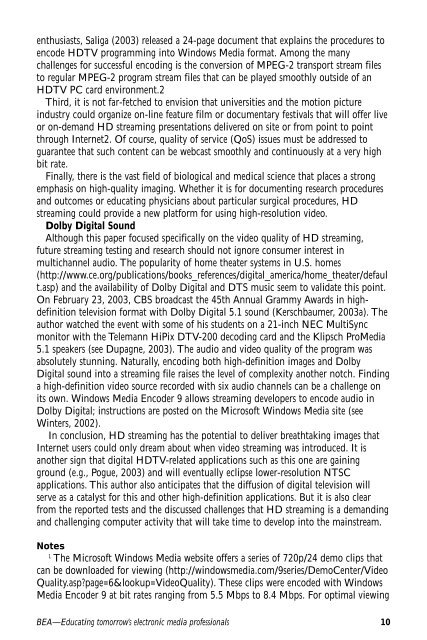JUNEFeedback
Issue 3 - Broadcast Education Association
Issue 3 - Broadcast Education Association
You also want an ePaper? Increase the reach of your titles
YUMPU automatically turns print PDFs into web optimized ePapers that Google loves.
enthusiasts, Saliga (2003) released a 24-page document that explains the procedures toencode HDTV programming into Windows Media format. Among the manychallenges for successful encoding is the conversion of MPEG-2 transport stream filesto regular MPEG-2 program stream files that can be played smoothly outside of anHDTV PC card environment.2Third, it is not far-fetched to envision that universities and the motion pictureindustry could organize on-line feature film or documentary festivals that will offer liveor on-demand HD streaming presentations delivered on site or from point to pointthrough Internet2. Of course, quality of service (QoS) issues must be addressed toguarantee that such content can be webcast smoothly and continuously at a very highbit rate.Finally, there is the vast field of biological and medical science that places a strongemphasis on high-quality imaging. Whether it is for documenting research proceduresand outcomes or educating physicians about particular surgical procedures, HDstreaming could provide a new platform for using high-resolution video.Dolby Digital SoundAlthough this paper focused specifically on the video quality of HD streaming,future streaming testing and research should not ignore consumer interest inmultichannel audio. The popularity of home theater systems in U.S. homes(http://www.ce.org/publications/books_references/digital_america/home_theater/default.asp) and the availability of Dolby Digital and DTS music seem to validate this point.On February 23, 2003, CBS broadcast the 45th Annual Grammy Awards in highdefinitiontelevision format with Dolby Digital 5.1 sound (Kerschbaumer, 2003a). Theauthor watched the event with some of his students on a 21-inch NEC MultiSyncmonitor with the Telemann HiPix DTV-200 decoding card and the Klipsch ProMedia5.1 speakers (see Dupagne, 2003). The audio and video quality of the program wasabsolutely stunning. Naturally, encoding both high-definition images and DolbyDigital sound into a streaming file raises the level of complexity another notch. Findinga high-definition video source recorded with six audio channels can be a challenge onits own. Windows Media Encoder 9 allows streaming developers to encode audio inDolby Digital; instructions are posted on the Microsoft Windows Media site (seeWinters, 2002).In conclusion, HD streaming has the potential to deliver breathtaking images thatInternet users could only dream about when video streaming was introduced. It isanother sign that digital HDTV-related applications such as this one are gainingground (e.g., Pogue, 2003) and will eventually eclipse lower-resolution NTSCapplications. This author also anticipates that the diffusion of digital television willserve as a catalyst for this and other high-definition applications. But it is also clearfrom the reported tests and the discussed challenges that HD streaming is a demandingand challenging computer activity that will take time to develop into the mainstream.Notes1The Microsoft Windows Media website offers a series of 720p/24 demo clips thatcan be downloaded for viewing (http://windowsmedia.com/9series/DemoCenter/VideoQuality.asp?page=6&lookup=VideoQuality). These clips were encoded with WindowsMedia Encoder 9 at bit rates ranging from 5.5 Mbps to 8.4 Mbps. For optimal viewingBEA—Educating tomorrow’s electronic media professionals 10
















